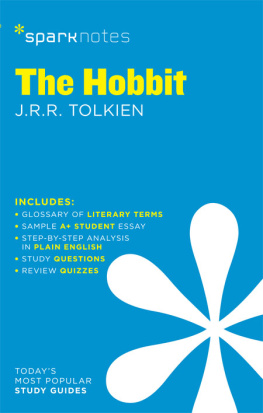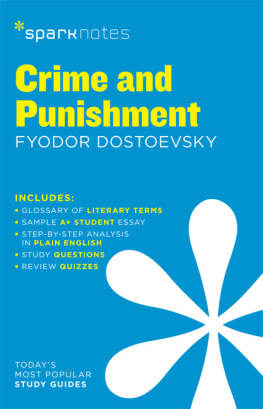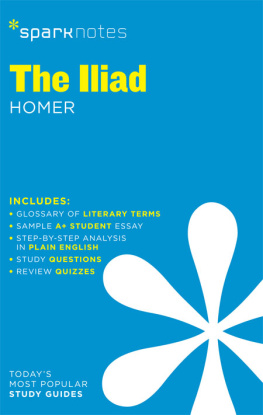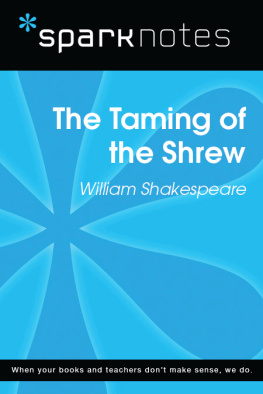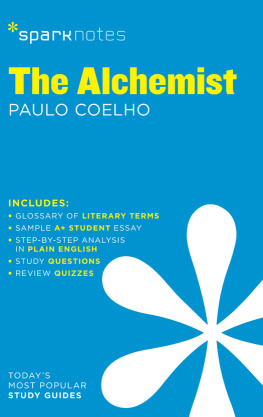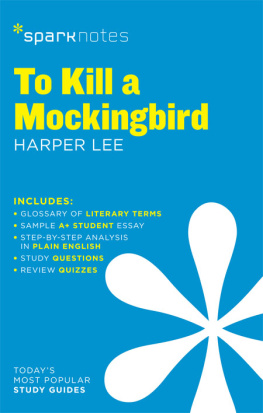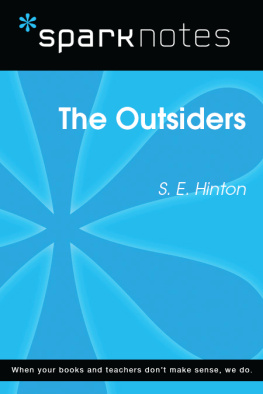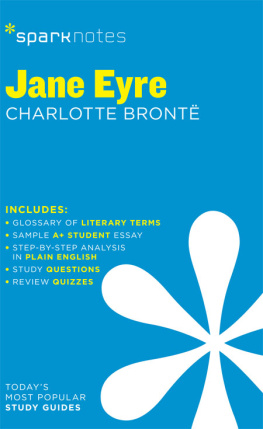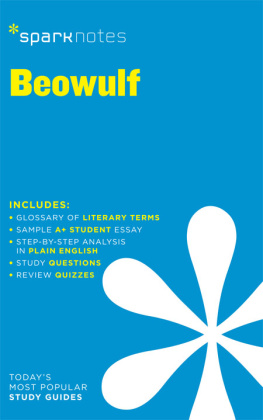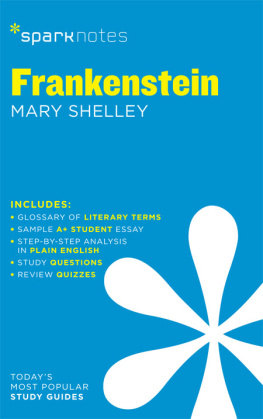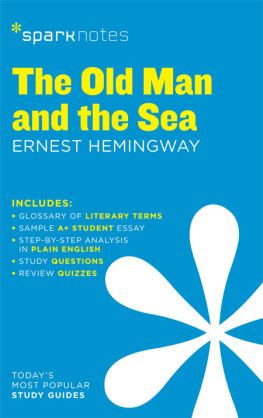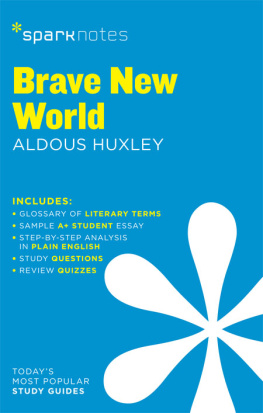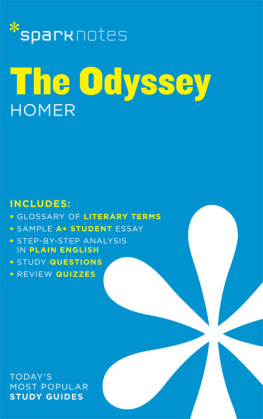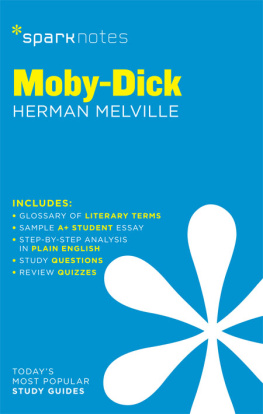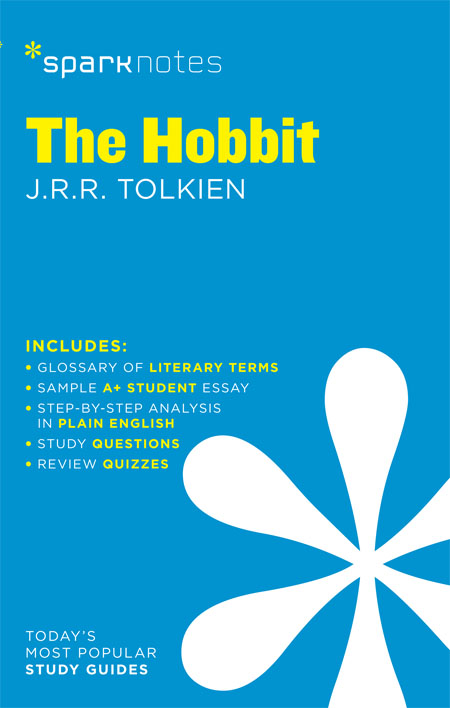The Hobbit
J. R. R. Tolkien
2003, 2007 by Spark Publishing
This Spark Publishing edition 2014 by SparkNotes LLC, an Affiliate of Barnes & Noble
All rights reserved. No part of this publication may be reproduced, stored in a retrieval system, or transmitted in any form or by any means (including electronic, mechanical, photocopying, recording, or otherwise) without prior written permission from the publisher.
Sparknotes is a registered trademark of SparkNotes LLC
Spark Publishing
A Division of Barnes & Noble
120 Fifth Avenue
New York, NY 10011
www.sparknotes.com /
ISBN-13: 978-1-4114-7166-5
Please submit changes or report errors to www.sparknotes.com/errors.
10 9 8 7 6 5 4 3 2 1
Context
J ohn Ronald Reuel Tolkien was born on January , 1892 , in Bloemfontain, South Africa. His parents had moved there from England so that his father, Arthur, could work for the bank of Africa. Tolkien lost both parents early in lifehis father died in Africa in 1896 after the rest of the family had returned to England, and his mother, Mabel, died in 1904 near Birmingham, England. After Mabels death, Tolkien and his younger brother, Hilary, came under the care of Father Francis Morgan, a friend of the familys. Soon after, Tolkien went to King Edwards School and then to Oxford.
At Oxford, Tolkien pursued a degree in English language and literature. He developed a particular passion for philology, the study of languages. While studying Old English, Anglo-Saxon, and Welsh poetry, he continued experimenting with a language of his own, which he had started to do in his youth. This language would form the groundwork for his imagined world known as Middle-Earth.
By 1916 , Tolkien had received his degree and married his childhood sweetheart, Edith Bratt. He eventually took a teaching position at Oxford. By 1929 , he had had his fourth child with Edith. During these years, he also began his great mythology of Middle-Earth, a compendium of stories called The Silmarillion. Out of these stories grew The Hobbit ( 1936 ), his first published work. A simple childrens story about a small person who takes part in great adventures, the novels playful tone and imagery made it a hit both with children and adults. The Hobbits success also gave Tolkien a huge public that was anxious to learn more about the meticulously developed world that he had created around his invented language and mythology, only a small part of which was detailed in The Hobbit.
The Hobbits plot and characters combined the ancient heroic Anglo-Saxon and Scandinavian epics Tolkien studied with the middle-class rural England in which he lived. In many ways, the novels charm and humor lie in transplanting a simple, pastoral Englishman of the 1930 s into a heroic medieval setting. Tolkien acknowledged that his hero, Bilbo Baggins, was patterned on the rural Englishmen of his own time.
By the time Tolkien began to work on the sequel to The Hobbit, he had developed a friendship with another well-known Oxford professor and writer, C. S. Lewis, author of The Chronicles of Narnia. Their friendship lasted for many years. Tolkien helped convert Lewis to Christianity (although Tolkien, a Roman Catholic, was disappointed that Lewis became a Protestant), and the two critiqued each others work as part of an informal group of writers known as the Inklings.
From 1945 to 1959 , Tolkien continued to teach at Oxford and wrote The Lord of the Rings trilogy, which served as a follow-up to The Hobbit. The trilogy brought Tolkien fame in England and America, but he was never a public figure. He continued work on The Silmarillion and other tales and led a quiet life. Despite his public acclaim, he was most comfortable with middle-class surroundings and peace in which to write and think. Tolkien died on September , 1973 . The Silmarillion was edited and published posthumously by his son Christopher in 1977 .
Plot Overview
B ilbo Baggins lives a quiet, peaceful life in his comfortable hole at Bag End. Bilbo lives in a hole because he is a hobbitone of a race of small, plump people about half the size of humans, with furry toes and a great love of good food and drink. Bilbo is quite content at Bag End, near the bustling hobbit village of Hobbiton, but one day his comfort is shattered by the arrival of the old wizard Gandalf, who persuades Bilbo to set out on an adventure with a group of thirteen militant dwarves. The dwarves are embarking on a great quest to reclaim their treasure from the marauding dragon Smaug, and Bilbo is to act as their burglar. The dwarves are very skeptical about Gandalfs choice for a burglar, and Bilbo is terrified to leave his comfortable life to seek adventure. But Gandalf assures both Bilbo and the dwarves that there is more to the little hobbit than meets the eye.
Shortly after the group sets out, three hungry trolls capture all of them except for Gandalf. Gandalf tricks the trolls into remaining outside when the sun comes up, and the sunlight turns the nocturnal trolls to stone. The group finds a great cache of weapons in the trolls camp. Gandalf and the dwarf lord Thorin take magic swords, and Bilbo takes a small sword of his own.
The group rests at the elfish stronghold of Rivendell, where they receive advice from the great elf lord Elrond, then sets out to cross the Misty Mountains. When they find shelter in a cave during a snowstorm, a group of goblins who live in the caverns beneath the mountain take them prisoner. Gandalf leads the dwarves to a passage out of the mountain, but they accidentally leave behind Bilbo.
Wandering through the tunnels, Bilbo finds a strange golden ring lying on the ground. He takes the ring and puts it in his pocket. Soon he encounters Gollum, a hissing, whining creature who lives in a pool in the caverns and hunts fish and goblins. Gollum wants to eat Bilbo, and the two have a contest of riddles to determine Bilbos fate. Bilbo wins by asking the dubious riddle, What have I got in my pocket?
Gollum wants to eat Bilbo anyway, and he disappears to fetch his magic ring, which turns its wearer invisible. The ring, however, is the same one Bilbo has already found, and Bilbo uses it to escape from Gollum and flee the goblins. He finds a tunnel leading up out of the mountain and discovers that the dwarves and Gandalf have already escaped. Evil wolves known as Wargs pursue them, but Bilbo and his comrades are helped to safety by a group of great eagles and by Beorn, a creature who can change shape from a man into a bear.
The company enters the dark forest of Mirkwood, and, making matters worse, Gandalf abandons them to see to some other urgent business. In the forest, the dwarves are caught in the webs of some giant spiders, and Bilbo must rescue them with his sword and magic ring. After slaying his first spider, Bilbo names his sword Sting. Shortly after escaping the spiders, the unlucky dwarves are captured by a group of wood elves who live near the river that runs through Mirkwood. Bilbo uses his ring to help the company escape and slips the dwarves away from the elves by hiding them inside barrels, which he then floats down the river. The dwarves arrive at Lake Town, a human settlement near the Lonely Mountain, under which the great dragon sleeps with Thorins treasure.
After sneaking into the mountain, Bilbo talks to the sly dragon Smaug, who unwittingly reveals that his armorlike scales have a weak spot near his heart. When Bilbo steals a golden cup from the dragons hoard, Smaug is furious and flies out of the mountain to burn Lake Town in his rage. Bard, a heroic archer, has learned the secret about Smaugs weakness from a thrush, and he fires an arrow into the dragons heart, killing him. Before Smaug dies, however, he burns Lake Town to the ground.

